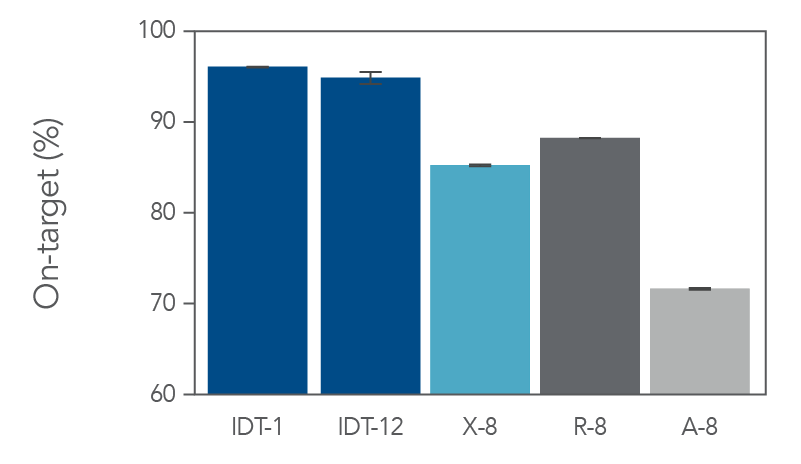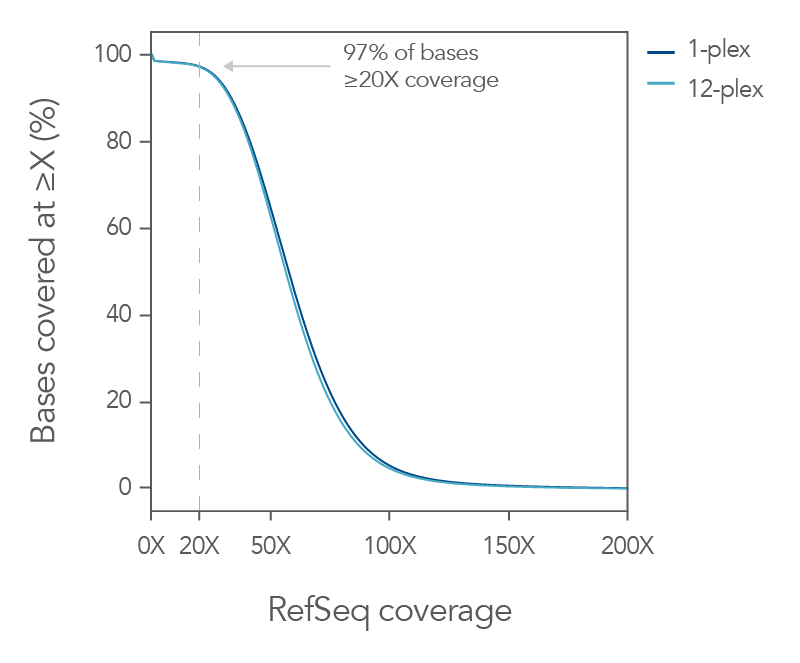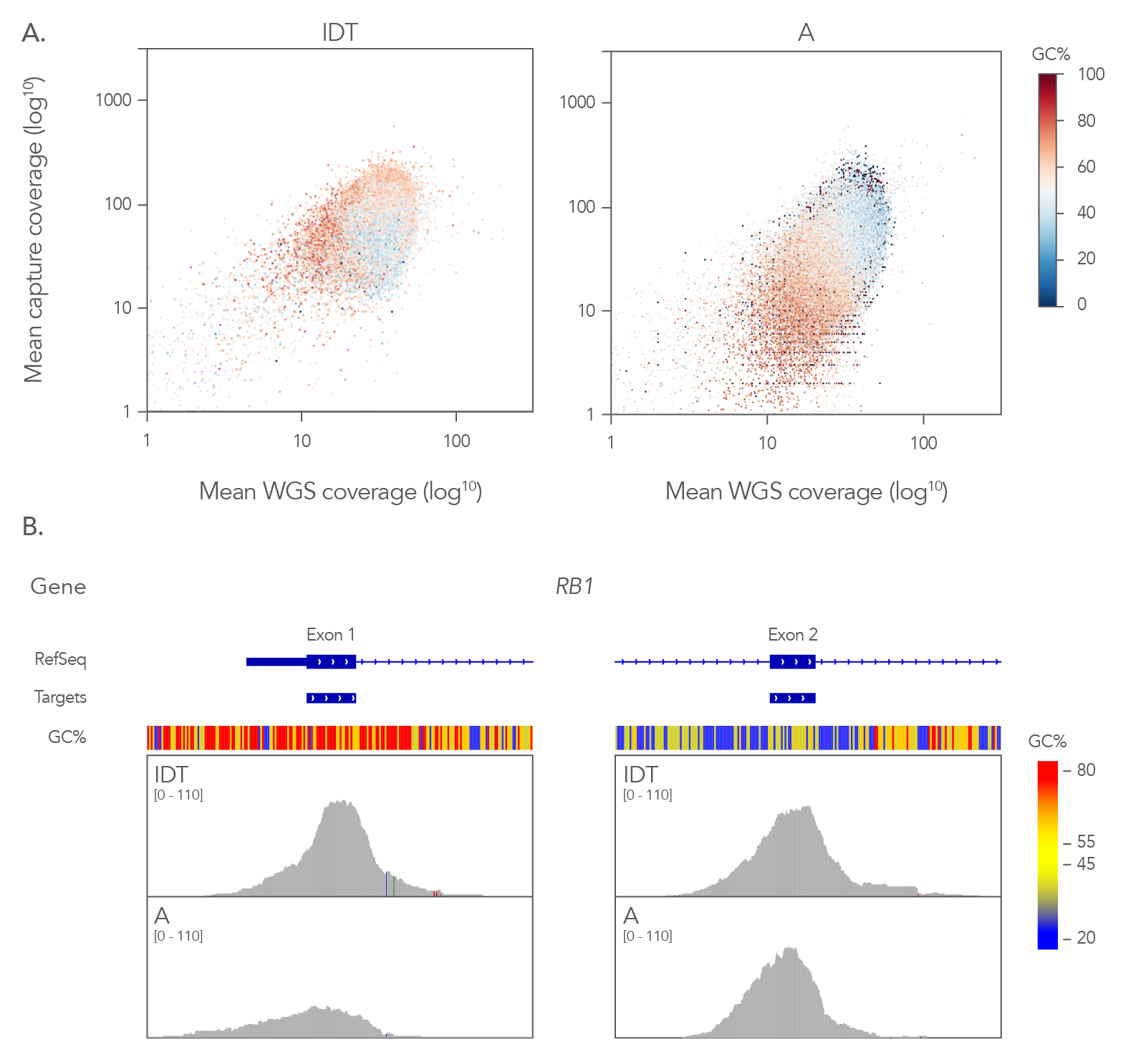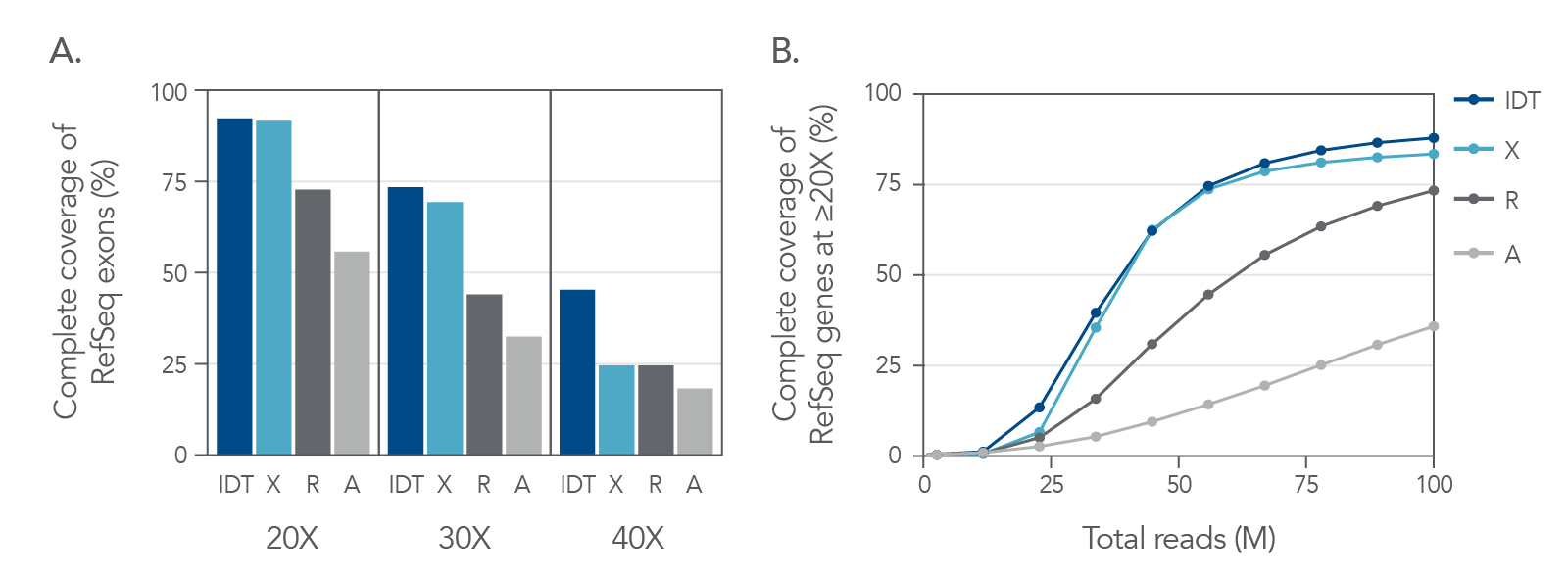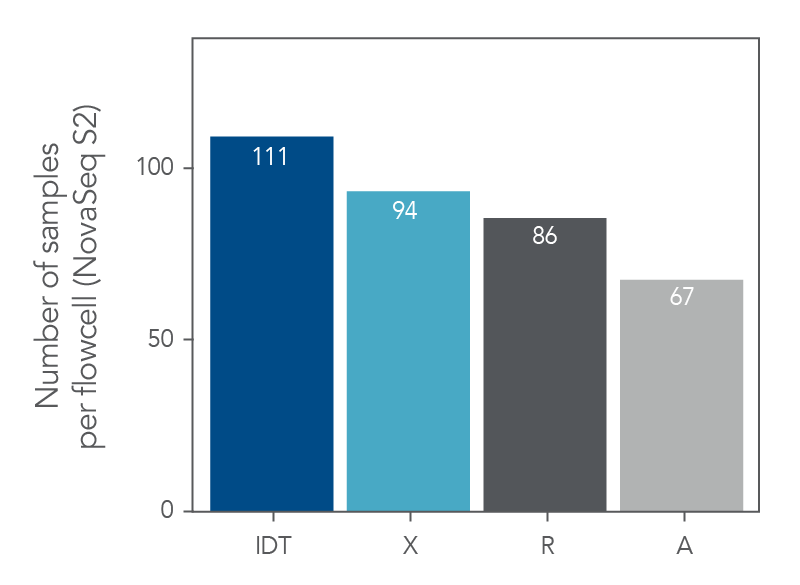xGen™ Exome Hybridization Panel
Higher on-target percentage—even with a 12-plex capture
The xGen Exome Hyb Panel v2 is designed using a target-aware algorithm that reduces off-target binding while maximizing coverage. We manufacture this panel under ISO 13485 standards as a single large lot, promoting equal representation and consistency from one aliquot to the next.
xGen NGS—made for whole exome sequencing.
Ordering
The xGen Exome Hyb Panel v2 consists of 415,115 individually synthesized, 5’ biotinylated, oligonucleotide probes. Each probe was quality tested and combined so that the panel contains the correct concentration.
- Shown to have higher on-target rate than leading array based competitors since each probe is individually synthesized and then added to the panel
- Consistency across lots as each probe was synthesized on a large scale prior to panel creation
- High end-to-end coverage of the RefSeq genes even in areas of high GC content (refer to Figure 4)
For customers who wish to purchase the legacy xGen™ Exome Hyb Panel v1, please contact us today.
For the xGen Hybridization and Wash Kit, xGen Universal Blockers, xGen Library Amplification Primer Mix, and/or xGen Human Cot DNA, please visit the xGen Hybridization Capture Core Reagents page.
Product details
Exome sequencing targets only the protein-coding regions of the genome. Since exons represent only 1% of the human genome, a method of separating these regions from noncoding DNA is important to study mutations that could be important for disease research. The captured genomic material must also be suitable for sequencing to a satisfactory depth of coverage for research on variant alleles and sensitive applications like copy number variation (CNV) detection. To provide this increased depth of coverage and enable high multiplexing of samples, the xGen Exome Hyb Panel v2 targets only the coding sequences (CDS) of human coding genes in the RefSeq 109 database.
Our xGen Exome Hyb Panel v2 consists of 5′ biotin–modified oligonucleotide probes that are individually synthesized and analyzed by electrospray ionization-mass spectrometry (ESI-MS) and optical density (OD) measurement. The probes are normalized before pooling to ensure that each probe is represented in the panel at the correct concentration. Probes that fail quality control are resynthesized. This manufacturing process gives the xGen Exome Hyb Panel v2 a unique advantage over array-derived pools in which missing or truncated probes cannot be identified before sequencing. IDT proprietary synthesis methods enable challenging probes—such as those with high GC and AT content—to be appropriately represented in the panel. The individual probes are synthesized on a larger scale than is used for array manufacturing, allowing IDT to produce a single, large lot of material that is aliquoted over time, providing consistent content from one aliquot to the next.
The xGen Exome Hyb Panel v2 consists of 415,115 probes that spans a 34 Mb target region (19,435 genes) of the human genome and 39 Mb of probe space—the genomic regions covered by probes. Our probes are designed using a new “capture-aware” algorithm and assessed with proprietary off-target analysis. All probes in the panel are manufactured under ISO 13485 standards, and then, mass spectrometry and dual quantification measurements of each probe are performed before they are pooled into the xGen Exome Hyb Panel v2. These measures ensure the quality of the probe and its appropriate representation in the final panel.
Product data
Consistent data from one aliquot to the next
Figure 1. Example coverage of the IDT xGen Exome Hyb Panel v2 vs. competitor. Two different users performed hyb captures on different days in different locations using different aliquots (lots) of the IDT xGen Exome
Hyb Panel v2. Captures were performed using 100 ng Coriell DNA NA12878 in a singleplex reaction (n=3). Bioinformatics analysis was done for 3-way coverage correlation comparison, a representative pair from each vendor is demonstrated here. The IDT
xGen Exome Hyb Panel v2 shows a linear regression line that mimics the predicted one-to-one correlation line with an r2 value of 0.76. In this example, IDT outperformed the competitor.
On-target coverage and uniformity of the xGen Exome Hyb Panel v2
Figure 2. The IDT whole exome sequencing workflow has higher on-target percentage in comparison to alternate suppliers. Sequencing libraries were prepared using enzymatic shearing and ligation-based library preparation using the library prep protocols from each vendor. Libraries were captured and multiplexed according to the vendor’s exome panel capture protocol (X-8, R-8, and A-8, where “8” signifies 8-plex captures, n=2). For IDT, we show both 1-plex (n=3) and 12-plex (n=2) captures (IDT-1 and IDT-12, respectively). Enriched libraries were sequenced on a NextSeq® instrument (Illumina) in high output mode using 2 x 100 bp paired-end reads for analysis. On-target bases were determined with Picard (percent selected bases) using 5 Gb per library.
Figure 3. Consistent uniform sequence coverage with the xGen Exome Hyb Panel v2. DNA libraries were created from 100 ng of human genomic DNA (Coriell) and enriched either as 1-plex captures (n=3) or as a single
12-plex (n=2) capture using the xGen Exome Hyb Panel v2. The enriched libraries were sequenced (2 x 100 bp reads) on a NextSeq® instrument (Illumina) and subsampled to 5 Gb. The data shows uniform coverage with a flanked on-target rate
of 94.7%, mean target coverage of 64.5X, and a duplication rate of 3.3% (calculated with Picard).
Coverage of RefSeq database with minimal sequencing
Figure 4. Coverage profile of the xGen Exome Hyb Panel v2 closely resembles whole genome data. (A) Comparing the coverage depths of different exome panels (8-plex, n=1) to coverage depth from whole genome sequencing (WGS) of a matched library shows that the xGen Exome Hyb Panel v2 closely matches WGS. Analysis of guanine-cytosine content (GC) shows that the xGen Exome Hyb Panel has a more effective capture of GC content (compare dark red and red dots in the right and left panels). (B) RB1 exons 1 and 2 show extremes of GC content with ~76% in exon 1 and ~38% in exon 2. A comparison of capture between IDT and supplier A shows a higher read depth across exon 1 for the xGen Exome Hyb Panel v2 on the Integrative Genomics Viewer (Broad Institute), whereas supplier A coverage has a lower number of reads of this exon with high GC content.
Figure 5. Exome coverage of the xGen Exome Hyb Panel v2. (A) 100 ng Coriell gDNA hybridization capture libraries (n=2) were sequenced with 5 Gb per sample while the percent of exons covered end-to-end at each read depth were calculated. The xGen Exome Hyb Panel v2 (IDT) shows the highest percentage of exons covered at each indicated depth (compared to suppliers X, R, and A). (B) The xGen Exome Hyb Panel v2 provides end-to-end RefSeq gene coverage at ≥20X. Individual samples were subsampled at different read depths (2 x 100 bp read length). The percentage of genes that were covered for every base of every exon at ≥20X was calculated at each read depth and plotted.
Maximize the number of samples per flowcell
Figure 6. xGen Exome Hyb Panel v2 can increase the number of samples loaded into a flowcell. DNA libraries were created from 100 ng of human genomic DNA (Coriell) and enriched either as 8-plex, n=1 (supplier R), 8-plex, n=2 (suppliers X and A) or 12-plex, n=2 (IDT) captures. The enriched libraries were sequenced (2 x 100 bp) on a NextSeq® instrument (Illumina) and the number of reads required to achieve 75X mean target coverage (Picard) per sample was estimated along with the number of samples that would fit on a NovaSeq™ S2 flowcell (Illumina).

